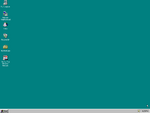BetaWiki:Featured article/2024-06
Windows 95 (codenamed Chicago) is a consumer version of Microsoft Windows released by Microsoft in 1995. It is the first major release in the Windows 9x operating system line, and was designed to be the successor of Windows 3.1. It is the first consumer-oriented version of Windows to include Windows Explorer, a move which was followed by its NT equivalent Windows NT 4.0 in 1996. It would be replaced by Windows 98, and Microsoft ended support for Windows 95 on 31 December 2001.
Windows 95 merged Microsoft's formerly separate MS-DOS and Microsoft Windows products, and featured significant improvements over its predecessor, most notably in the graphical user interface (GUI) and in its simplified "plug-and-play" features. It improved upon 16-bit Windows by introducing a hybrid 16/32-bit kernel and eliminating the need for an existing installation of MS-DOS, making it a standalone operating system (running alongside MS-DOS). Microsoft focused on improving the usability of Windows with technologies such as Plug-and-Play, long file names (VFAT), the Start menu, an updated desktop, Internet Explorer, Mail, built-in networking, and virtual device drivers. Many of the paradigms introduced with Windows 95 remain in use today.
